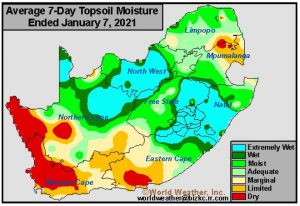We have seen a right mix of rain and sunshine in recent weeks across South Africa, which bodes well for all agricultural subsectors – field crops, horticulture and livestock.
From my observations driving across some of South Africa’s regions these past few weeks, the crops look good from a distance. Also, conversations with farmers in various areas have been uplifting.
Nevertheless, some areas need constant monitoring in the coming weeks. Parts of the North West, Free State, KwaZulu-Natal and northern regions of the Eastern Cape received excessive rainfall in the past few days. While rain is always appreciated when it is extreme, it could cause problems.
I am now back in Pretoria and haven’t travelled through these provinces following the rains to observe the crop conditions lately. However, the insights from folks on the ground, such as Free State Agriculture, have been comforting. While there are a few areas that experienced crop damages from the floods, fields are reportedly in good shape from an aggregate level. On January 6, Free State Agriculture’s statement opened with this optimistic line, noting that “most farmers in the Free State are rejoicing over the good rains that have occurred in the province recently.”
The areas that experienced crop damage are few farmers in the Hoopstad and Bultfontein, amongst other districts.
In the northern regions of the Eastern Cape, from what I can tell from conversations with fellow countrymen of the north of Transkei, agriculture conditions are relatively good. The rains of the few days did not cause crop damages.
An almost stark contrast from the provinces mentioned above; there are still fields in the northeast of the country that are a little too dry for ideal crop conditions. These are specifically, some regions of Mpumalanga, and the southwestern regions of the Eastern Cape. A good soaking of rain in these regions would be welcome. We illustrate these regions in exhibit 1 below (see orange and red coloured areas).
We are in a La Niña year, which means higher rainfall throughout the summer season. On January 8, the South African Weather Service indicated that “the multi-model rainfall forecast for late-summer (Jan-Feb-Mar) and early-autumn (Feb-Mar-Apr) indicate wetter conditions over most of the country, most notably the summer rainfall areas.”
The rains will provide beneficial moisture when summer crops are in pollination stages of development. All else being equal, we are likely looking at another good harvest for South Africa’s agriculture in 2021 as I argued in this post at the end of 2020.
Food price inflation view
Also, to emphasize a point I made at the end of 2020; South Africa’s annual food price inflation will likely remain contained and probably average no more than 5% in 2021. However, earlier months of the year could show higher numbers due to elevated grain prices. The pass-through of higher grain prices towards the end of 2020 and the beginning of this year could appear early in the first quarter numbers of food price inflation but soon dissipate.
The expected large grain harvests in the 2020/2021 production season will most probably translate through softening grain prices from around February 2021. It will appear on food price inflation from the second quarter of the year or so, with a lag.
This year, there aren’t expected unusual price trends in other significant products in the food price inflation basket. I will update these views as more information becomes available.














